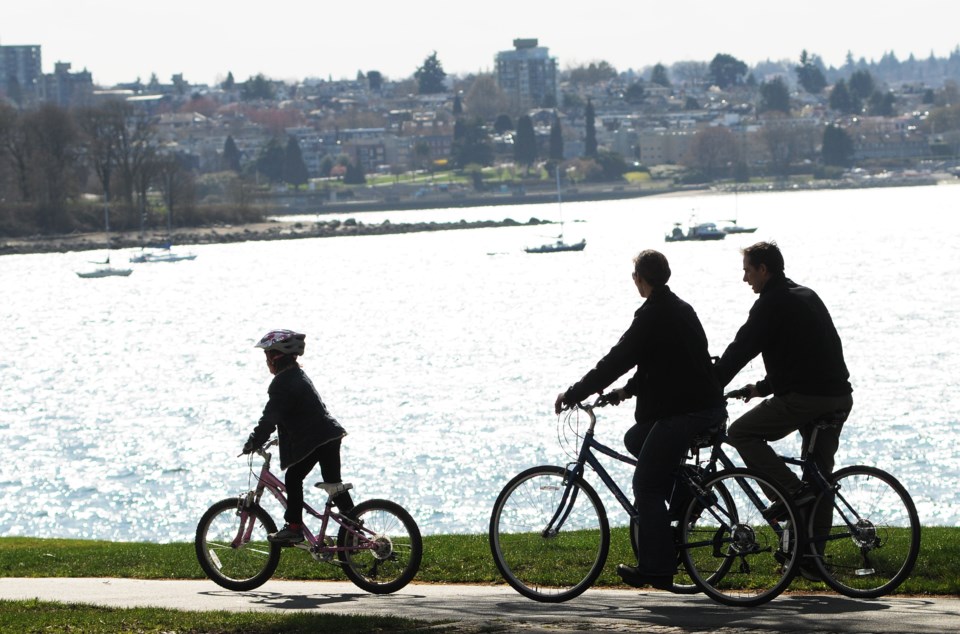I’ve had the privilege of pedalling around a number of great North American cities in the past few years, including Montreal, Toronto, Portland, San Francisco and Los Angeles. Every time I return home, I end up asking myself the exact same question: “What if everything we think we know about bicycle safety in Vancouver is wrong?”
Why is it, for example, that Vancouver and Seattle remain the only large cities on the continent where cycling without a helmet is prohibited by law?
How is this counterproductive piece of legislation still on the books, despite subsequent studies finding a 30 per cent reduction in cycling rates among people aged 16 to 30, along with no appreciable affect on head injury rates, and the provincial law also forcing an unnecessary barrier to Vancouver’s now seven-year-old effort to establish a bike-sharing scheme?
When public bike-share programs first appeared in the United States, the press and public (including — most famously — Jon Stewart on The Daily Show) predicted blood on the streets. It never materialized, and now, seven years, 36 cities, and 23 million rides later, not a single bike-share user has lost their life.
Furthermore, both head injury rates and overall injury rates declined among the general biking population despite a substantial increase in the total number of miles cycled. As it turns out, letting thousands of slow moving, upright, untrained and un-helmeted cyclists loose may be the best possible safety measure a city can take.
It is becoming abundantly clear there is far more safety in numbers than Styrofoam. Studies report that doubling the number of cyclists results in a one-third reduction in the number of car-bike collisions.
And as Brent Toderian, a former Vancouver city planner and helmet law critic, stated at an SFU roundtable discussion last month: “There is no doubt that the safest thing for cyclists is more cyclists.”
Moreover, the mistaken sense of invincibility provided by safety gear drastically changes the dynamic between road users. Armoured cyclists have been shown to indulge in “risk compensation” by taking additional gambles, riding quicker and more recklessly than they otherwise would. Similarly, motorists have been found to conduct themselves differently around cyclists dressed in protective equipment, leaving noticeably less space when passing, and travelling even faster around them.
The Vancouver Police Department stubbornly remains one of the few municipal forces in the Lower Mainland (having issued 13,166 — or 90 per cent — of the 14,549 total helmet tickets between 2008 and 2012) dedicating valuable resources to this supposed public health measure — under the guise of addressing road safety. It is obvious that assigning a pair of traffic cops to park on a protected bike lane (statistically ten times safer than anywhere else in the city) for a few days each summer, to meet an arbitrary quota of $29 fines has little to do with keeping road users safe.
And when the vast majority of the cycling-specific violations issued by the VPD (405 — or 90 per cent — of 450 total tickets in the first half of 2014) are for not wearing a helmet, it becomes clear they are in fact just padding statistics with low-hanging fruit, while tougher-to-enforce measures specifically enacted to prevent collisions — headlights, safety bell/horn, stop sign/crosswalk running, sidewalk cycling, etc. — go almost completely ignored and unpunished.
The police’s actions become all the more puzzling when you consider the fact that 11,097 of the 13,154 $29 fines issued between 2008 and 2012 remain unpaid. In short — the helmet law provides them with a simple, visually effective means of appearing serious about bicycle safety — without actually indulging in any of the difficult, more complicated work associated with it.
As Vancouver continues to invest in and expand a physically separated bike network, there will be more and more adults who feel perfectly safe cycling without Styrofoam. My wife and I stopped wearing ours a couple of years ago and we know quite a few perfectly intelligent, risk-adverse grown-ups who recently decided they no longer need theirs because of improved infrastructure or the fact that they switched to a slower, more upright bicycle (or even a cargo bike).
It’s the sure-fire sign of a comfortable, mature, sensible cycling city, and the sooner municipal officials and advocacy groups stop acquiescing to the criminalization of these citizens, the more likely it is we can build a bicycle culture worth bragging to the world about.
Chris Bruntlett is the co-founder of Modacity, “a multi-service consultancy focused on inspiring healthier, happier, simpler forms of urban mobility through words, photography and film.” See modacitylife.com and Twitter/Facebook/Instagram: @modacitylife.



